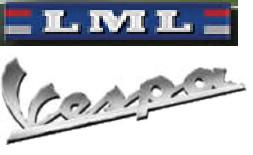The Dakar rally is probably the most gruelling and dangerous motor race in the world. Motorcycles, cars, quad bikes and trucks compete, not so much with each other, but with the race itself, to survive each year’s course. Competitors slog through each mile in danger of serious injury and death.
In 1980 a French team of 4 riders, put together by Jean-Francois Piot, decided that this all sounded wonderful and that they would enter the race. On their Vespas.
So on the first of January, 1980, these brave (mad) riders set out with 211 other cars, bikes and trucks. On the 23rd of January M. Simonot and B. Tcherniawsky were amongst the 81 competitors to make it into Dakar and cross the finish line, having ridden their Vespa PX 200s from Paris to Dakar, across 7 countries and 10, 000km of brutal terrain.
Maybe they weren’t so crazy after all. Two out of four Vespas finished the race (50%), while only 79 out of 211 other vehicles crossed the finish line (37%).
So if you are planning on tackling the Dakar rally, do it on a Vespa!
In 1977, Piaggio launched the Vespa PX scooter, which immediately developed a fanatical following as a symbol of Italian style throughout the world.
Today, the air-cooled two-stroke PX remains a cult figure, with the 150cc version still the biggest selling Vespa in history.
In Australia, the PX200 has always been the dominant player, but 31 years of history is now drawing to a close with the last container recently arriving from Italy. It's now last drinks for the classic Vespa with its handlebar-controlled four-speed transmission and a design that has never gone out of style
 The PX has evolved over time, but has retained a core set of 'selling' points, including a unique design, practicality and ease of use, a pressed steel monocoque frame and space for a spare wheel. A virtually indestructible engine has seen two PX200s reaching the finish line of one of the toughest off-road events in the world, the Paris-Dakar Rally.
The PX has evolved over time, but has retained a core set of 'selling' points, including a unique design, practicality and ease of use, a pressed steel monocoque frame and space for a spare wheel. A virtually indestructible engine has seen two PX200s reaching the finish line of one of the toughest off-road events in the world, the Paris-Dakar Rally.
 The PX has evolved over time, but has retained a core set of 'selling' points, including a unique design, practicality and ease of use, a pressed steel monocoque frame and space for a spare wheel. A virtually indestructible engine has seen two PX200s reaching the finish line of one of the toughest off-road events in the world, the Paris-Dakar Rally.
The PX has evolved over time, but has retained a core set of 'selling' points, including a unique design, practicality and ease of use, a pressed steel monocoque frame and space for a spare wheel. A virtually indestructible engine has seen two PX200s reaching the finish line of one of the toughest off-road events in the world, the Paris-Dakar Rally.Famous actors and actresses have a long history of courting the world's most famous scooter. In photo shoots, films and on the set, the Vespa has been a "travel companion" for names like Raquel Welch, Ursula Andress, Charlton Heston, John Wayne and Henry Fonda. Other famous vespa riders include: Milla Jovovich, Marcello Mastroianni, Gary Cooper, Anthony Perkins, Jean-Paul Belmondo, Nanni Moretti, Sting, Antonio Banderas, Matt Damon, Gérard Depardieu, Jude Law, Nicole Kidman, Eddie Murphy and Owen Wilson.














